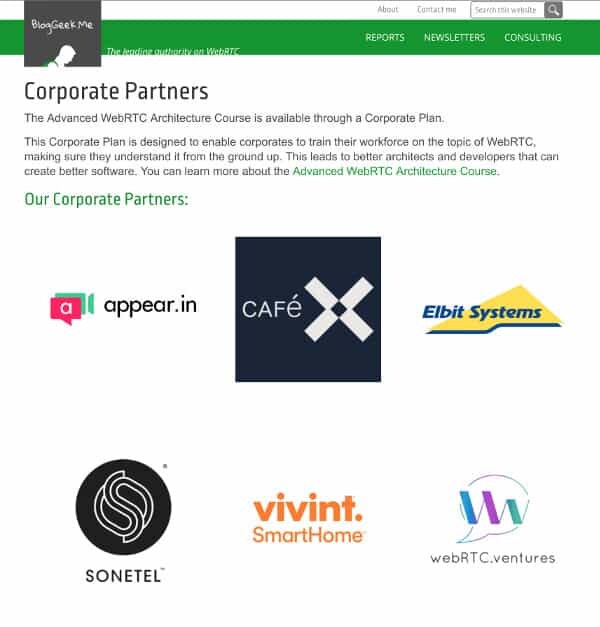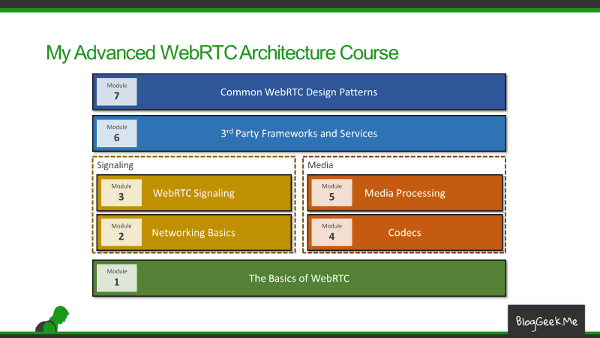Looking for a WebRTC Tutorial? Search no more. My online WebRTC course is here.
I will be relaunching my Advanced WebRTC Architecture Course next week, so it is time to see what you’ll find in this WebRTC training program I’ve created and fine-tuned for over a year now.
Prefer watching and listening more than reading? Join my free webinar on Wednesday for a quick lesson on WebRTC architecture related topics, where I’ll also be explaining the WebRTC training course and its contents.
The sections below explain the various parts of this unique WebRTC training. These are decidedly focused on delivering the best learning experience possible.
WebRTC Training Main Modules
The course is designed and built around 7 main modules:
Each module includes multiple lesson, and each lesson is a recorded video session of anywhere between 10-40 minutes of length. Most lessons also include additional links and some written content in them.
Module 1 gives you the baseline information about what WebRTC is. Consider it your introduction to the topic.
Modules 2-3 focus on signaling. They’ll take you from an understanding of UDP and TCP up to deciding what signaling protocol to use in each case and why.
Modules 4-5 are all about media. They explain voice and video codecs – in the context of their relevance to WebRTC. They also deal with the various media architectures available in group calling and recording scenarios.
Module 6 is all about the ecosystem. It lists the different strategies developers have in front of them when designing a WebRTC application, and then goes into details of each one of these.
Module 7 brings it all together. It takes different scenarios and use cases, analyzes them and builds the necessary architectures to support each use case. This is where the theory comes into practice.
The total length of the recordings in all modules and lessons? Over 15 hours.
You progress with the material at your own pace, jumping between lessons as you see fit, or through the original order they were laid out in.
If you’re looking for something to print and share, there’s a PDF version of the WebRTC course syllabus available.
Get Your WebRTC Questions Answered in the Course Forum
The course itself is supplemented with an online forum.
I’ve been contemplating making that forum a Slack channel or a Facebook group. Decided against it. While that may change with time, the course does have a forum built into it.
When you enroll to the course, you also gain access to the forum, which is where you can ask questions and get answers to them.
At any point in time.
Be it about a specific lesson, or a challenge you have in what you’re currently doing at work with WebRTC.
And if sharing openly isn’t your thing, you can always just email me directly.
WebRTC Training Office Hours
Twice a year, a series of office hours are provided for the course.
There are 12 such live sessions, taking place on roughly a weekly basis. They happen in 2 different times of the day, to fit different timezones.
These office hours include two parts in them:
- Me rambling about a topic. Call it a live lesson. It can be something from the actual course, or just thoughts and updates on what’s been going on lately with WebRTC out there
- Q&A. In this part, those enrolled to the course can ask anything they want. It is a part of the course which not many use, but those that do seem to enjoy it and derive benefit from it
The office hours are recorded and available for playback as well, so if you miss a session – you can always return to it and play it back.
WebRTC Course Bonus Materials
Besides all the 7 course module, I’ve added a bonus module.
This one contains some extra lessons as well as cheat sheets and templates that are spread all over my site in an easy to reach location.
What lessons are in the bonus materials?
4 recorded lessons
- WebRTC standardization
- Writing RFP requirements for WebRTC
- Media algorithms
- Using testRTC
The media algorithms lesson is really important. It covers topic that I touch only lightly during the course such as echo cancellation and jitter buffer.
2 recorded guest lessons
In my last round of the course, appear.in, who took the corporate plan, were also kind enough to share two new guest lessons:
- Video Quality in WebRTC
- Deploying (co)TURN on AWS
Philipp Hancke and Bradley T. Hughes were the instructors for these two and I found myself learning a lot in these lessons as well. Now, they are part of the course bonus materials.
What’s New in This Round of the WebRTC Course?
This is the third time I am running this course, and the second round of updates to it.
- I’ve updated some of the materials where appropriate (someone told me recently that Apple is doing something with WebRTC, so it had to find its way to the course 😉 )
- I also recorded a session from scratch because apparently, the audio recording of that one wasn’t the best
- The bonus materials (described above), are going to go away. They will be available only during course launch periods (=this week) or for corporate plans
- There’s a new eBook that is going to be added as a bonus to the course. It is called “Built to Scale”, and it is a look behind the scenes of how meet.jit.si is… built to scale

A Few Questions Answered About the WebRTC Course
I am now adding an option to take my WebRTC training as part of every consulting project I take. Sometimes, the customer takes me up on the offer, and other times they don’t. There are questions that get asked almost all the time about the course by these customers, so I decided to answer the most common ones here.
How long will it take to work through the WebRTC course?
It is entirely up to you.
There’s over 15 hours of recorded content in the course. More if you start going through the links, external slide decks and videos that I share in the course lessons.
But at the end of the day:
- You decide on the pace of your WebRTC studies
- You decide which lessons to start with first
- You decide if there are lessons you prefer skipping
- You decide if you want to watch to a specific lesson again
If you take a lesson in each working day, then 2 months is approximately what you’ll need to get from start to end.
Is there any prerequisite to taking this WebRTC training?
This WebRTC training program assumes you have some good understanding of technology. The rest – it fills in with the various modules of the course.
You don’t need to have knowledge in VoIP to take this course. You don’t need to be a web developer either. What you do need, is to have some technical grasp and understanding.
If you already have prior knowledge, then that’s fine – this WebRTC course isn’t forcing you to take its modules and lessons by their order, so you can skip to the relevant topics that interest you.
Is there a certificate?
As most online learning courses go, so too the WebRTC course offers a certificate.
Once you’ve completed the course, you will be receiving a WebRTC certificate indicating you’ve passed the course.
For companies, there’s a separate plan, which enables them to hold a badge of the WebRTC course. You can find the vendors that have taken this plan in the corporate partners page.

What’s Next?
Want to learn more about media in WebRTC? Join this free webinar to see an analysis of a real case study I came across recently. What did the company had in mind to build and how they botched their architecture along the way.
And if you’re really serious, enroll to my Advanced WebRTC Architecture Course.


Looks like a great course.. still available in 2019?
Warning – the following question is very vague! 🙂
I am wandering for someone quite new into webrtc, what is the likelihood in your honest opinion of creating a “video chat service” from scratch as an individual? (or with limited resources) – sorry for the high-level question.. I am trying to get my head around all the frameworks, and with the steep learning curve, not sure how realistic for a green-fields webrtc coder to implement such a thing..
Sam,
The course is still available and relevant – I update it rather frequently. It can help you out wrap your brains around the technology and help you with that learning curve.
You’ll understand what it means to develop what you need and what the tools for the job are.
The course can now be found at https://webrtccourse.com